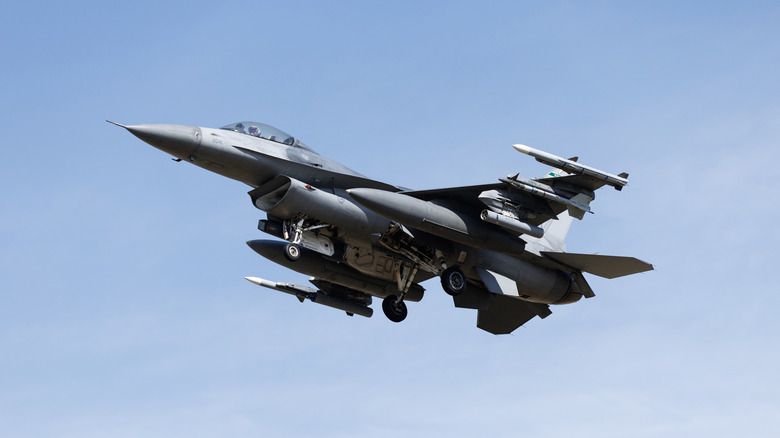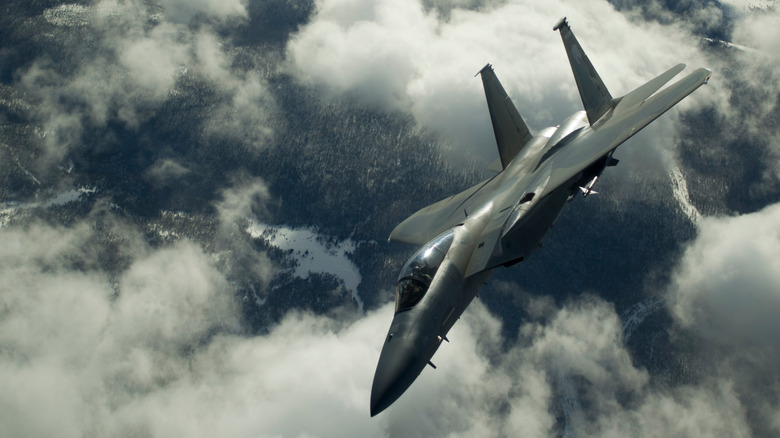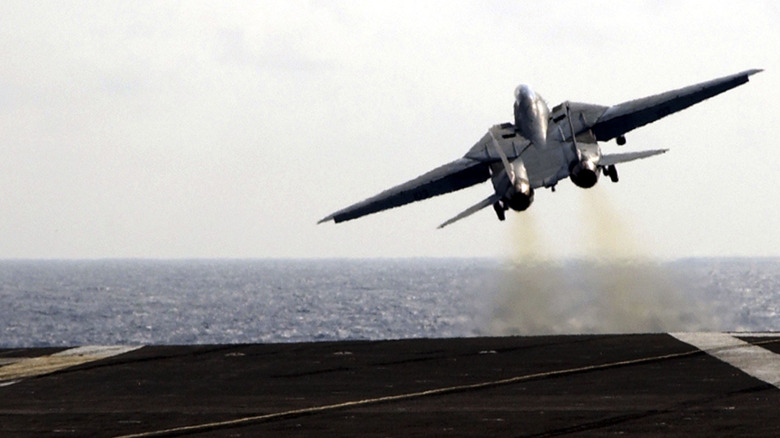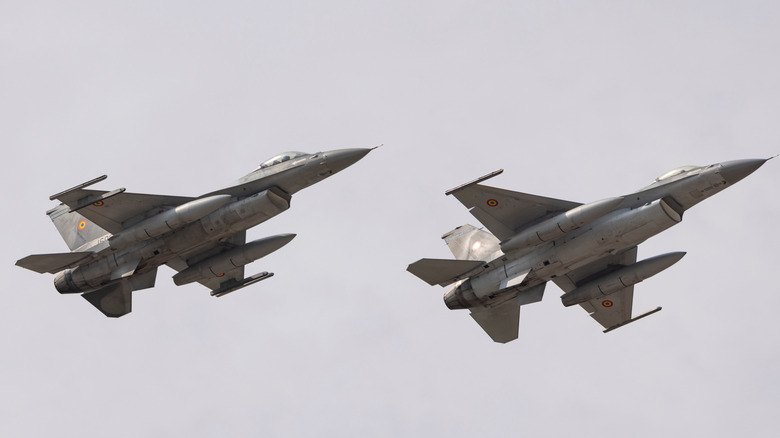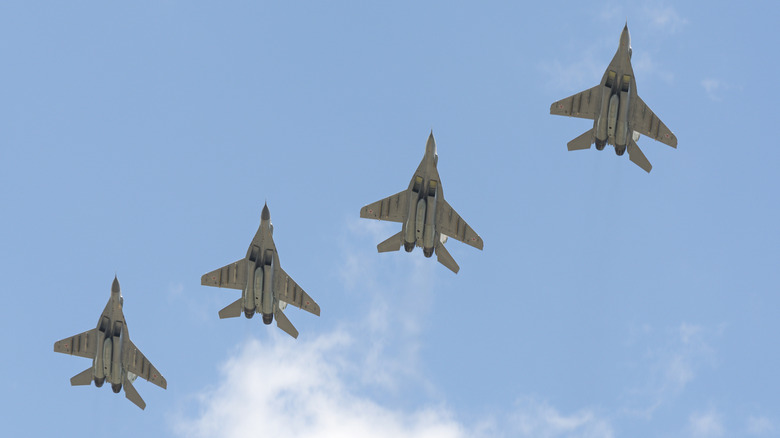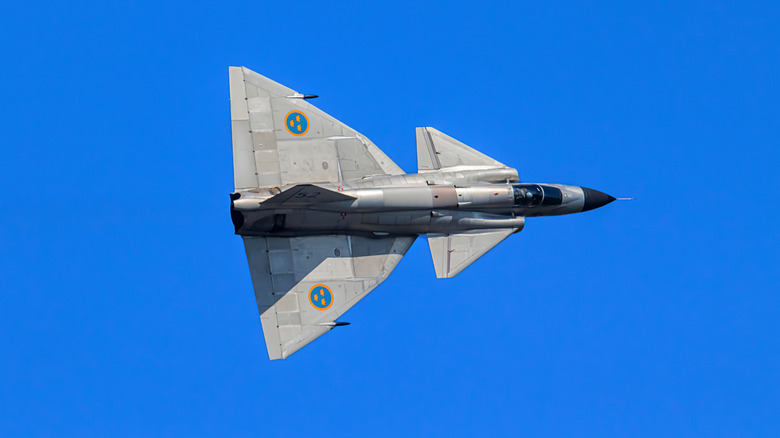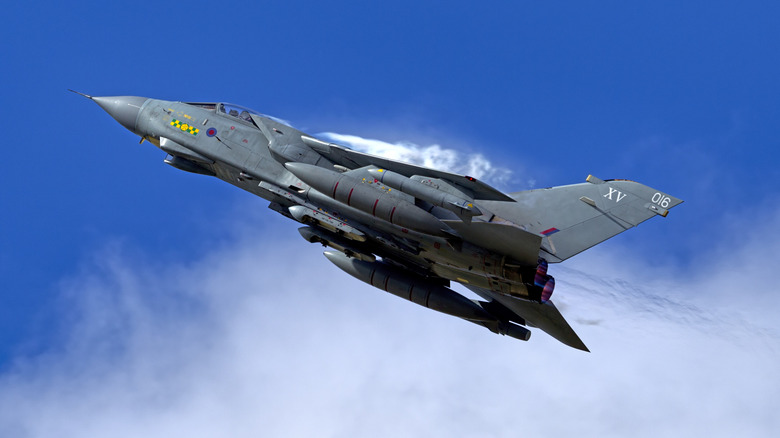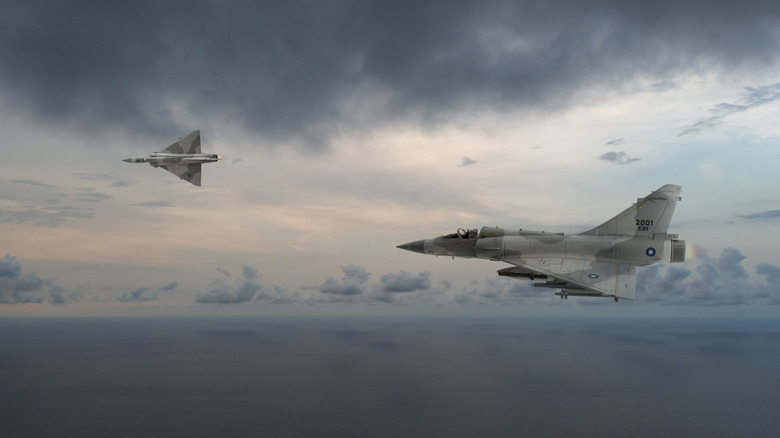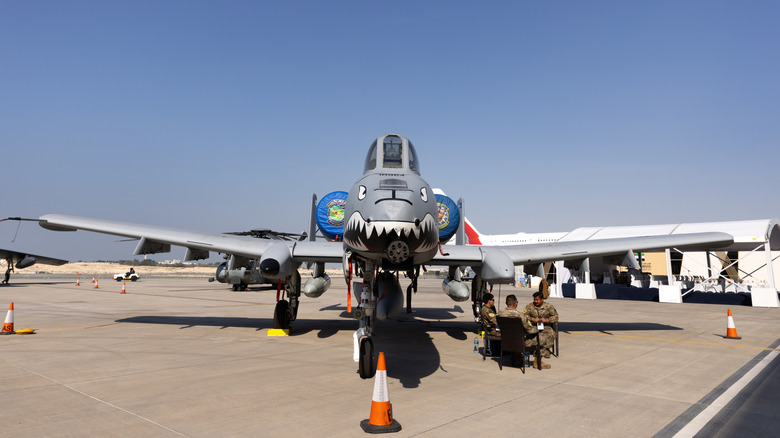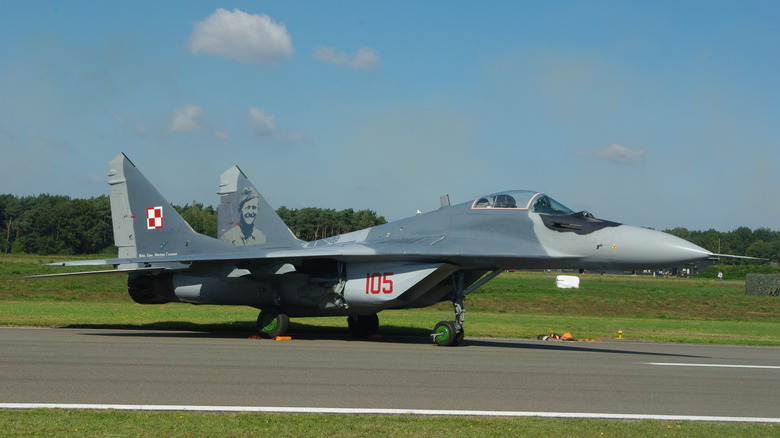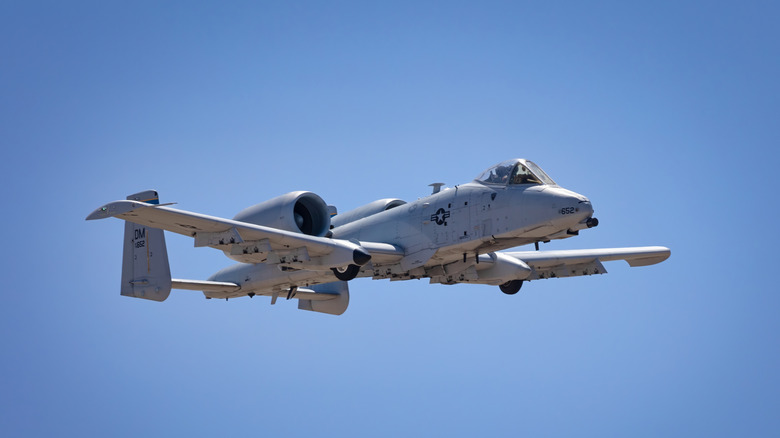12 Of The Best Fighter Jets Built In The 1970s
Allow us to take you back to the most aggressive arms race in history, back to a time when the cold war was at its height — the 1970s. Schoolchildren were being made to practice duck-and-cover drills, the Russians were repurposing a bomber for their space program, we equipped some of our Coast Guard ships with missiles, and we even got introduced to the likes of the Ekranoplan, a plane that would use the ground effect to fly — also known as the Caspian Sea Monster. At the time, international tensions between the two world superpowers — Russia and America — were at breaking point, with the Cuban missile crisis having been narrowly averted only a few years prior.
The other countries in Eastern Europe, as well as our allies in Western Europe, were worried about getting caught in the crossfire, which is why everyone was investing heavily in their armed forces. It was flat-out technological warfare, where entire nations threw their brightest minds and deepest pockets at creating flying machines that could dominate the skies. The brief was simple: build something faster, deadlier, and more advanced than whatever the other side had. As a result, we saw some of the deadliest, fastest, stealthiest, you-name-it-est fighter jets in history. And out of those many, many jets released in the 1970s, we've researched the best ones — here are 12 of them.
McDonnell-Douglas F-15 Eagle and Strike Eagle
We're going to start our list off strong, with what is possibly the most dominant fighter jet of the last century: The F-15 Eagle and its Strike Eagle variant. Its top speed easily crosses the Mach 2 point, which is double the speed of sound, meaning that this masterpiece could (and probably still can) outrun most things that humans have ever built. The F-15 has never been lost in aerial combat and has won more than 100 combat engagements.
Now, we did lose an F-15 during Operation Desert Shield, which later turned into Desert Storm, but that was by anti-air artillery, not by another jet. The Strike Eagle variant that debuted a few years later has twin thrusters that provide 29,000 pounds of force from each engine, allowing this demon of a jet to carry some 16,000 pounds of ordnance. Further, the Strike Eagle can also hold 750 gallons of fuel in each of its tanks, which gave it (at the time anyway) an unparalleled range of 2,400 miles, though that's with three external fuel tanks, which would reduce armament carrying capacity.
Sukhoi SU-22
The next plane on our list is almost as impressive as the F-15, and was actually one of the Soviet Union's first jets that used a "swing wing" — one of the coolest features ever used on fighter jets. Produced until 1991, the SU in the name is an abbreviation of Sukhoi, the company that manufactured these planes. The term "swing wing" refers to jets that had variable geometry wings, or in other words, planes that could change their wing designs and ratios mid-flight or even mid-engagement.
Specifically, the SU-22 had three main wing positions: one at 61 degrees for high-speed flying, a 28-degree position for low-speed flights, and one 45-degree intermediate layout for hybrid use. It had a total payload-carrying capacity of 9,370 pounds, which included all its offensive missiles, bombs, and other armaments that could be mounted on eight external pylons — an impressive number for the time. Power for the later generations of this semi-formidable fighter jet came from turbojet engines, generating 24,700 pounds of force that pushed the SU-22 to a maximum operating speed of Mach 2.09, or 1,550 mph.
Grumman F14A Tomcat
Now, this is a plane that even lay people will have heard of, because it was popularized by the 1986 Hollywood film "Top Gun" — but let us tell you, the movie didn't even begin to scratch the surface of how legendary this plane was. They called it the F-14A Tomcat, and it was produced for the United States Navy between 1970 to 1992 by the Grumman Aircraft Corporation, now known as Northrop-Grumman.
The main reason the Navy needed the F-14A Tomcat was that the Soviets had made incredible advancements with their long-range bombers, which meant that they could fly deep into American territory. The Tomcat was designed to engage these long-range threats at high altitude from BVR (beyond visual range) while maintaining superiority over the fighter escorts that would accompany the infiltrating party. And boy, did Grumman deliver, with a jet that had a top speed of Mach 2.01 (1,544 mph), a maximum range of 2,400 miles, a payload of 14,500 pounds, and an armory including AIM-54 Phoenix, AIM-7 Sparrow, as well as AIM-9 Sidewinder missiles: all factors that would keep Soviet bomber pilots awake at night.
IAI Kfir
Next, let's talk about a fighter jet that wasn't from the U.S. or the Soviet Union, by taking a look at Israel. After struggles and numerous conflicts with their Arab neighbors, the Israeli air force recognized the strategic need to have air superiority, and for this purpose, they made the Kfir — which literally translates to "lion cub" in English. And honestly, there's no better way to describe the Kfir: it's tenacious, can put up one hell of a fight, and is one of the most capable jets not made by a global superpower.
Now, it was produced in-house, but was actually a derivation of the formidable French Dassault Mirage 5 which was reverse-engineered by Israel to make a plane called the Nesher, which later evolved into the Kfir of modernity — and would remain Israel's main fighter jet until the U.S. gave them the F-15 in later years. The numbers were impressive: a top speed of Mach 2.3, a maximum range of 1,300 miles, a maximum payload of 13,415 pounds, with a climb rate of 45,900 feet per minute, and a service ceiling of about 58,000 feet — which meant that the Kfir could reach its service ceiling in under 75 seconds.
Lockheed-Martin F-16 Fighting Falcon
And now, we arrive back stateside, for the next fighter jet on our list is the legendary F-16, called the "Fighting Falcon". It was produced by Lockheed-Martin from 1976, a company that does not shy away from experimenting with design, as seen by their F-117A Nighthawk stealth bomber — but as far as design goes, the F-16 was not much of a departure from the blueprints. It has a single engine, 40-degree fixed wing, and a lot (seriously, a lot) of firepower, which comfortably puts it in the "multi-role" fighter jet category.
In terms of offense, the F-16 carries two 2,000-pound bombs, two AIM-9 Sidewinder missiles, two AIM-120 missiles, and two external fuel tanks holding 2,400 pounds each. It also has a 20 mm canon, capable of holding 500 rounds. The engine is a reliable turbofan unit made by Pratt & Whitney, capable of producing 23,000 pounds of static thrust while at sea level. This engine lets the F-16 reach a maximum speed of Mach 1.71 (1,319 mph), and also gives the jet an impressive range of 1,260 miles on a single refill. Lockheed-Martin says there are more than 3,000 F-16s still being used across 29 countries. Thank God it's on our side — so we can live, laugh, and let Lockheed Martin handle the rest.
MiG-25 Foxbat
The MiG-25 Foxbat, one of the Soviet fighter jets that the U.S. actually feared during the Cold War, is the next jet on our list. Just like the Pentagon told Lockheed-Martin to make the F-16 in order to counter the USSR's supersonic bombers, the Soviets instructed the Mikoyan and Gurevich Design Bureau (MiG for short) to make something that could counter our potentially devastating Valkyrie long-range bomber.
In addition, the Soviets also wanted it to counter American SR-71 Blackbirds alongside the XB-70 Valkyries, both of which could outrun any Soviet plane of the time. As a result, MiG came out with the Foxbat in 1970, featuring twin turbojet engines from Tumansky, each of which was capable of making 22,500 pounds of thrust with the afterburners engaged.
Upon its debut, the MiG 25 proceeded to set a whopping 29 world records. The jet was so feared that it kept the SR-71 Blackbird out of Soviet airspace for a while. It had a maximum speed of Mach 3.2, though it was limited to Mach 2.83 (2,171 mph), a range of 1,075 miles, and a service ceiling of 80,000 feet, all numbers that contributed heavily to "Foxbat Hysteria", as it was called. However, the MiG sometimes proved to be more bark than bite, especially when the CIA convinced a Soviet pilot, Viktor Belenko, to defect to Japan with his MiG 25 in 1976.
Saab JA-37 Viggen
Next up is an often-overlooked fighter jet that comes to us from the Nordic country of Sweden. Famously, the Saab 37 is the only aircraft in history that is confirmed to have gotten a positive missile lock on an SR-71 Blackbird, which is a terrifying thought.
The SR-71's entire point was to be so fast that nothing could catch it, and then, out of nowhere, a dorito-shaped jet from a country half the size of Texas manages to best it — that's just the Swedes for you. It was produced by Saab — yes, the same company that makes vehicles for the road, among other things — to replace the ageing and obsolete fighter jets that Sweden had at the time. Specifically, the Swedes wanted this new jet, nicknamed the "Thunderbolt", to replace both their Saab 32 Lansen strike aircraft, as well as the Saab 35 Draken reconnaissance aircraft, which the Saab 37 did quite well across its five-plus variants.
Interestingly, the engine for the Viggen came from Volvo, and was a turbofan unit producing approximately 28,000 pounds (125 kN) of thrust. This, coupled with the pound weight of the 37 Viggen meant that it had a top speed of Mach 2.1 (1,386 mph), a range of 1,243 miles, and a service ceiling of about 59,000 feet — all of which goes to say that it was potentially the most impressive plane of the 1970s, period.
Dassault Mirage F1
Certainly, a mention must go out to the French, for their creation of the exquisite albeit not-so-performant Dassault Mirage F1, a plane that wouldn't look out of place in a design catalog even today. The Mirage F1 project kicked off when Dassault corporate realized that huge planes with huge engines would no longer be viable for export, which is when they designated funds to make a small, stealthy aircraft capable of reaching speeds above Mach 2.0.
The F1 was meant to improve upon the Mirage III and Mirage IV planes already in service, with a key differentiator being the Mirage F1's ability to land on rough airstrips at an impressively low approach speed of just 140 knots (162 mph). Its SNECMA Atar 9K-50 engine produces 16,000 pounds of thrust, which easily propels the F1 to its maximum speed of Mach 2.2 (1,688 mph). Furthermore, the F1 can operate at up to 52,000 feet, all of which combined to make the Mirage F1 a massive commercial success, with more than 50% of total production being made for export.
Panavia Tornado GR1
The Panavia Tornado GR1 is also a multirole fighter jet from the '70s that doesn't get the love it should, because it mostly flew under the radar — literally. It played a pivotal role during Operation Desert Storm (that the British called Operation Granby), by absolutely annihilating Iraqi air defenses, including runways, which prevented Iraqi jets from mounting a proper, organized response. The project to design and build the GR1 began in the late 1960s, when the United Kingdom, Italy, and Germany collaborated to make a plane that could operate at low heights but also maintain supersonic speeds — and as a result, the Panavia company was established in West Germany.
The company showcased the prototype in 1974, and operational deliveries to the three funding countries began at the end of the decade in 1980, meaning that it was actually in service for more than a decade before Operation Desert Shield and Desert Storm. Panavia also decided to take the "fighter" in fighter jet very seriously, arming the GR1 with two 27 mm canons, two AIM-9 sidewinder missiles, and a whopping 18,000 pounds of ordnance. Power came from two turbofans provided by Turbo Union, each making 15,800 pounds of thrust, which propelled the GR1 to a top speed of Mach 1.89 (1,453 mph), and also gave it a range of 2,100 nautical miles — not bad for a plane developed in such a short timeframe.
Mirage 2000
We do also want to give another passing mention to the French, by way of including the Dassault Mirage 2000 jet that is still used extensively by the Indian Air Force. It wasn't very special, and didn't distinguish itself much from the Mirage lineup of which it was an iteration, but it was reliable, relatively affordable, and available for delivery within a couple of years.
The 2000 series had a combat takeoff weight of about 21,000 pounds, and just like the Mirage F1, more than 50% of the units produced (about 600 total) were exported to Brazil, India, Egypt, Greece, and four other countries. The Mirage 2000 has a top speed of Mach 2.2 (1,688mph), with some versions getting a range of 2,072 mph.
Fairchild Republic A10 Thunderbolt II
The A-10 Thunderbolt made by Fairchild Republic is very different from the ones you've seen so far on this list. Though it is officially called the "Thunderbolt", ground forces from all branches of our military will almost universally call it the "Warthog." It is a plane that has achieved legendary status in every theater in which it has served. Specifically, the Warthog was designed as a close-ground support aircraft, even though it was initially developed to be an anti-armor air support gunship.
It is extraordinarily maneuverable, but has a low top speed of just 420 mph, and a range of just 800 nautical miles, but that's all it needs. That aside, the A-10 is best known for its 30 mm GAU-8/A cannon and 16,000-pound ordnance capacity across all its external pylons. This allows the A10 to maintain engagements for a ridiculously long time as it would seldom run out of ammo, which, coupled with the fact that it is an amazingly durable aircraft capable of flying with half a wing missing, on just one engine, and with several other components inoperable, means that American forces can always count on support from the 'Hog.
MiG 29
If you're wondering, MiG stands for "Mikoyan-Gurevich", which is the name of the state-owned design bureau that manufactured these jets. Just like the MiG-25 Foxbat mentioned above, the MiG-29 is also an air-superiority multi-role fighter aircraft produced towards the end of the Cold War. It had its maiden flight in 1977, but due to supply chain constraints, it would not enter service until 1983, when it was too late to make much of a difference to Soviet-American geopolitics.
Known by the North Atlantic Treaty Organization (NATO) as the "Fulcrum", the MiG-29 was a fairly impressive upgrade over the Mig-25, coming with a range of 1,802 miles, the same service ceiling of 59,000 feet, and a maximum takeoff weight of 40,741 pounds — although it had a lower top speed of Mach 1.98 (1,520 mph). Note that almost all of these stats are inferior to the F-16 Fighting Falcon, which is why we said that the MiG is an impressive upgrade, not an impressive jet. The funding constraints of a dying USSR were evident, having frittered away all their money on projects like the Duga Radar of 1976 and the Ekranoplan of the 1980s.
Methodology
We applied several criteria in this list. Firstly, if a jet was dominant in one particular area, such as the F-15 Eagle and Strike Eagles were, they got a spot on this list. If a plane was particularly good at something (for example: MiG 25 – speed, A-10 Thunderbolt – close support, etc.), then it earned a place on our list.
If the plane was a sales success, like the Dassault F1, then again, it earned a place on our list. Those were the three main criteria — dominance, specialty, success — but as always, there are outliers. For instance, if a plane did something truly remarkable, like the Saab 37 Viggen locking onto an SR-71 Blackbird, we put it on our list. In short, every single fighter jet on our list is something truly special.
